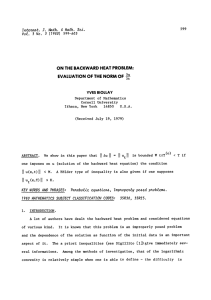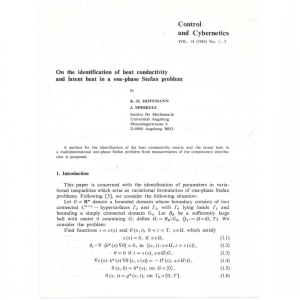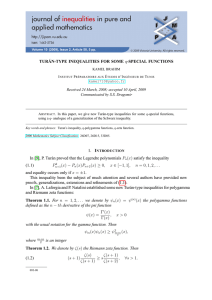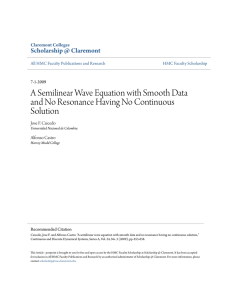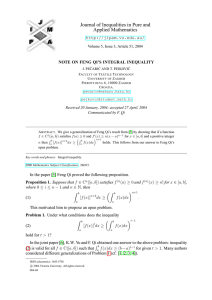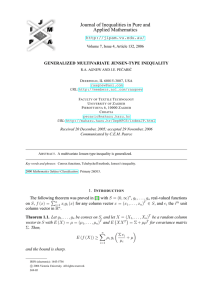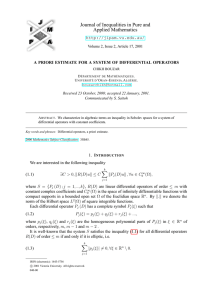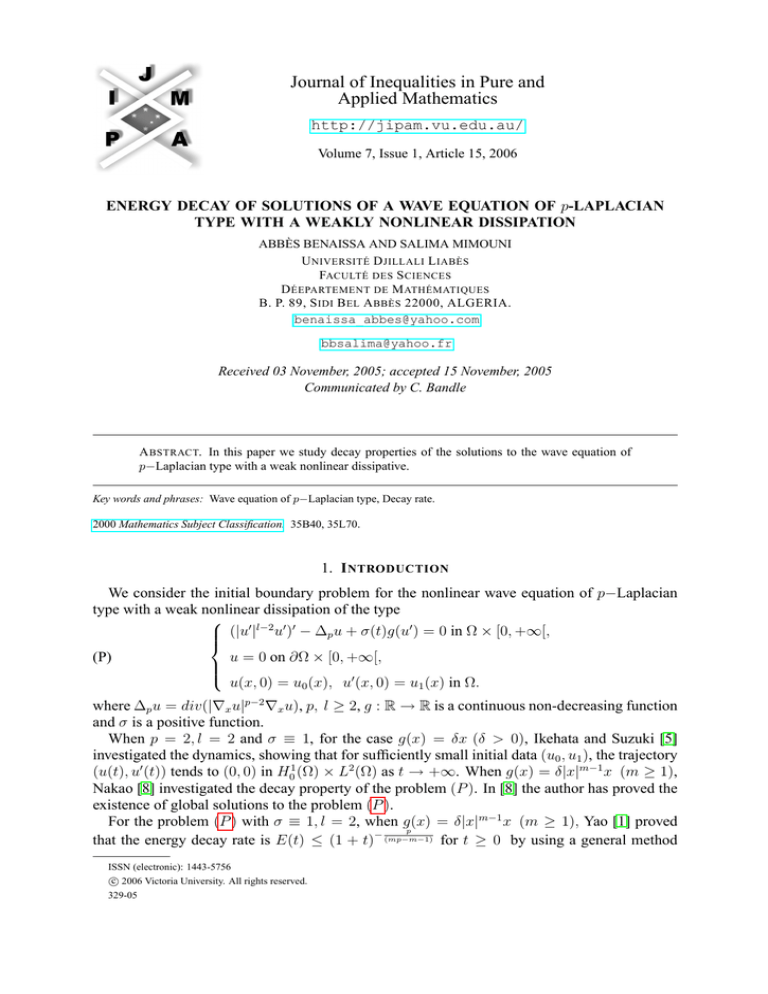
Journal of Inequalities in Pure and
Applied Mathematics
http://jipam.vu.edu.au/
Volume 7, Issue 1, Article 15, 2006
ENERGY DECAY OF SOLUTIONS OF A WAVE EQUATION OF p-LAPLACIAN
TYPE WITH A WEAKLY NONLINEAR DISSIPATION
ABBÈS BENAISSA AND SALIMA MIMOUNI
U NIVERSITÉ D JILLALI L IABÈS
FACULTÉ DES S CIENCES
D ÉEPARTEMENT DE M ATHÉMATIQUES
B. P. 89, S IDI B EL A BBÈS 22000, ALGERIA.
benaissa_abbes@yahoo.com
bbsalima@yahoo.fr
Received 03 November, 2005; accepted 15 November, 2005
Communicated by C. Bandle
A BSTRACT. In this paper we study decay properties of the solutions to the wave equation of
p−Laplacian type with a weak nonlinear dissipative.
Key words and phrases: Wave equation of p−Laplacian type, Decay rate.
2000 Mathematics Subject Classification. 35B40, 35L70.
1. I NTRODUCTION
We consider the initial boundary problem for the nonlinear wave equation of p−Laplacian
type with a weak nonlinear dissipation of the type
(|u0 |l−2 u0 )0 − ∆p u + σ(t)g(u0 ) = 0 in Ω × [0, +∞[,
u = 0 on ∂Ω × [0, +∞[,
(P)
u(x, 0) = u0 (x), u0 (x, 0) = u1 (x) in Ω.
where ∆p u = div(|∇x u|p−2 ∇x u), p, l ≥ 2, g : R → R is a continuous non-decreasing function
and σ is a positive function.
When p = 2, l = 2 and σ ≡ 1, for the case g(x) = δx (δ > 0), Ikehata and Suzuki [5]
investigated the dynamics, showing that for sufficiently small initial data (u0 , u1 ), the trajectory
(u(t), u0 (t)) tends to (0, 0) in H01 (Ω) × L2 (Ω) as t → +∞. When g(x) = δ|x|m−1 x (m ≥ 1),
Nakao [8] investigated the decay property of the problem (P ). In [8] the author has proved the
existence of global solutions to the problem (P ).
For the problem (P ) with σ ≡ 1, l = 2, when g(x) = δ|x|m−1 x (m ≥ 1), Yao [1] proved
p
that the energy decay rate is E(t) ≤ (1 + t)− (mp−m−1) for t ≥ 0 by using a general method
ISSN (electronic): 1443-5756
c 2006 Victoria University. All rights reserved.
329-05
2
A BBÈS B ENAISSA
AND
S ALIMA M IMOUNI
introduced by Nakao [8]. Unfortunately, this method does not seem to be applicable in the case
of more general functions σ and is more complicated.
Our purpose in this paper is to give energy decay estimates of the solutions to the problem
(P ) for a weak nonlinear dissipation. We extend the results obtained by Yao and prove in some
cases an exponential decay when p > 2 and the dissipative term is not necessarily superlinear
near the origin.
We use a new method recently introduced by Martinez [7] (see also [2]) to study the decay
rate of solutions to the wave equation u00 − ∆x u + g(u0 ) = 0 in Ω × R+ , where Ω is a bounded
domain of Rn . This method is based on a new integral inequality that generalizes a result of
Haraux [4].
Throughout this paper the functions considered are all real valued. We omit the space variable
x of u(t, x), ut (t, x) and simply denote u(t, x), ut (t, x) by u(t), u0 (t), respectively, when no
confusion arises. Let l be a number with 2 ≤ l ≤ ∞. We denote by k · kl the Ll norm over Ω.
In particular, the L2 norm is denoted by k · k2 . (·) denotes the usual L2 inner product. We use
familiar function spaces W01,p .
2. P RELIMINARIES AND M AIN R ESULTS
First assume that the solution exists in the class
u ∈ C(R+ , W01,p (Ω)) ∩ C 1 (R+ , Ll (Ω)).
(2.1)
λ(x), σ(t) and g satisfy the following hypotheses:
(H1) σ : R+ → R+ is a non increasing function of class C 1 on R+ satisfying
Z +∞
(2.2)
σ(τ )dτ = +∞.
0
(H2) Consider g : R → R a non increasing C 0 function such that
g(v)v > 0 for all v 6= 0.
and suppose that there exist ci > 0; i = 1, 2, 3, 4 such that
1
(2.3)
c1 |v|m ≤ |g(v)| ≤ c2 |v| m if |v| ≤ 1,
(2.4)
c3 |v|s ≤ |g(v)| ≤ c4 |v|r for all |v| ≥ 1,
.
where m ≥ 1, l − 1 ≤ s ≤ r ≤ n(p−1)+p
n−p
We define the energy associated to the solution given by (2.1) by the following formula
l−1 0 l 1
E(t) =
ku kl + k∇x ukpp .
l
p
We first state two well known lemmas, and then state and prove a lemma that will be needed
later.
Lemma 2.1 (Sobolev-Poincaré inequality). Let q be a number with 2 ≤ q < +∞ (n =
np
1, 2, . . . , p) or 2 ≤ q ≤ (n−p)
(n ≥ p + 1), then there is a constant c∗ = c(Ω, q) such that
kukq ≤ c∗ k∇ukp
for
u ∈ W01,p (Ω).
Lemma 2.2 ([6]). Let E : R+ → R+ be a non-increasing function and assume that there are
two constants q ≥ 0 and A > 0 such that
Z +∞
E q+1 (t) dt ≤ AE(S), 0 ≤ S < +∞,
S
J. Inequal. Pure and Appl. Math., 7(1) Art. 15, 2006
http://jipam.vu.edu.au/
E NERGY D ECAY
3
then we have
E(t) ≤ cE(0)(1 + t)
−1
q
∀t ≥ 0,
if q > 0
and
E(t) ≤ cE(0)e−ωt ∀t ≥ 0,
if q = 0,
where c and ω are positive constants independent of the initial energy E(0).
Lemma 2.3 ([7]). Let E : R+ → R+ be a non increasing function and φ : R+ → R+ an
increasing C 2 function such that
φ(0) = 0
φ(t) → +∞ as t → +∞.
and
Assume that there exist q ≥ 0 and A > 0 such that
Z +∞
E(t)q+1 (t)φ0 (t) dt ≤ AE(S),
0 ≤ S < +∞,
S
then we have
E(t) ≤ cE(0)(1 + φ(t))
−1
q
∀t ≥ 0,
if q > 0
and
E(t) ≤ cE(0)e−ωφ(t) ∀t ≥ 0,
if q = 0,
where c and ω are positive constants independent of the initial energy E(0).
Proof of Lemma 2.3. Let f : R+ → R+ be defined by f (x) := E(φ−1 (x)). f is non-increasing,
f (0) = E(0) and if we set x := φ(t) we obtain
Z φ(T )
Z φ(T )
q+1
q+1
f (x) dx =
E φ−1 (x)
dx
φ(S)
φ(S)
T
Z
=
E(t)q+1 φ0 (t) dt
S
≤ AE(S) = Af (φ(S))
0 ≤ S < T < +∞.
Setting s := φ(S) and letting T → +∞, we deduce that
Z +∞
f (x)q+1 dx ≤ Af (s) 0 ≤ s < +∞.
s
By Lemma 2.2, we can deduce the desired results.
Our main result is the following
Theorem 2.4. Let (u0 , u1 ) ∈ W01,p × Ll (Ω) and suppose that (H1) and (H2) hold. Then the
solution u(x, t) of the problem (P ) satisfies
(1) If l ≥ m + 1, we have
Z t
E(t) ≤ C(E(0)) exp 1 − ω
σ(τ ) dτ
∀t > 0.
0
(2) If l < m + 1, we have
E(t) ≤
J. Inequal. Pure and Appl. Math., 7(1) Art. 15, 2006
C(E(0))
Rt
σ(τ ) dτ
0
p
! (mp−m−1)
∀t > 0.
http://jipam.vu.edu.au/
4
A BBÈS B ENAISSA
AND
S ALIMA M IMOUNI
Examples
1) If σ(t) =
1
(0 ≤ θ ≤ 1), by applying Theorem 2.4 we obtain
tθ
E(t) ≤ C(E(0))e1−ωt
1−θ
if θ ∈ [0, 1[, l ≥ m + 1,
(1−θ)p
E(t) ≤ C(E(0))t− mp−m−1
and
if 0 ≤ θ < 1, l < m + 1
p
E(t) ≤ C(E(0))(ln t)− (mp−m−1)
if θ = 1, l < m + 1.
1
2) If σ(t) = θ
, where k is a positive integer and
t ln t ln2 t . . . lnk t
(
ln1 (t) = ln(t)
lnk+1 (t) = ln(lnk (t)),
by applying Theorem 2.4, we obtain
p
E(t) ≤ C(E(0))(lnk+1 t)− (mp−m−1)
if θ = 1, l < m + 1,
(1−θ)p
p
E(t) ≤ C(E(0))t− mp−m−1 (ln t ln2 t . . . lnk t) mp−m−1 if 0 ≤ θ < 1, l < m + 1.
1
3) If σ(t) = θ
, by applying Theorem 2.4, we obtain
t (ln t)γ
(1−θ)p
γp
E(t) ≤ C(E(0))t− mp−m−1 (ln t) mp−m−1
(1−γ)p
− mp−m−1
E(t) ≤ C(E(0))(ln t)
p
− mp−m−1
E(t) ≤ C(E(0))(ln2 t)
if 0 ≤ θ < 1, l < m + 1,
if θ = 1, 0 ≤ γ < 1, l < m + 1,
if θ = 1, γ = 1, l < m + 1.
Proof of Theorem 2.4.
First we have the following energy identity to the problem (P )
Lemma 2.5 (Energy identity). Let u(t, x) be a local solution to the problem (P ) on [0, ∞) as
in Theorem 2.4. Then we have
Z Z t
E(t) +
σ(s)u0 (s)g(u0 (s)) ds dx = E(0)
Ω
0
for all t ∈ [0, ∞).
Proof of the energy decay. From now on, we denote by c various positive constants which may
be different at different occurrences. We multiply the first equation of (P ) by E q φ0 u, where φ
is a function satisfying all the hypotheses of Lemma 2.3 to obtain
Z T
Z
q 0
0=
E φ
u((|u0 |l−2 u0 )t − ∆p u + σ(t)g(u0 )) dx dt
S
Ω
T Z T
Z
Z
q 0
0 0 l−2
0 q−1 0
q 00
= E φ
uu |u | dx −
(qE E φ + E φ ) uu0 |u0 |l−2 dxdt
Ω
S
S
T
Ω
T
Z 3l − 2
l − 1 02 1
−
E q φ0 |u0 |2 dxdt + 2
E q φ0
u + |∇u|p
l
l
p
S
Ω
S
Ω
Z T
Z T
Z
2
+
E q φ0 σ(t)ug(u0 ) dxdt + 1 −
E q φ0 k∇ukpp dxdt.
p
S
Ω
S
Z
Z
J. Inequal. Pure and Appl. Math., 7(1) Art. 15, 2006
Z
dxdt
http://jipam.vu.edu.au/
E NERGY D ECAY
5
We deduce that
T
Z
Z T
q+1 0
q 0
0 0 l−2
(2.5) 2
E φ dt ≤ − E φ
uu |u | dx
S
Ω
Z
+
S
T
0
q 00
Z
φ + E φ ) uu0 |u0 |l−2 dxdt
S
Ω
Z
Z
Z T
Z
3l − 2 T q 0
0 l
q 0
+
E φ
|u | dxdt −
E φ
σ(t)ug(u0 ) dxdt.
l
Ω
Ω
S
S
(qE E
q−1 0
Since E is nonincreasing, φ0 is a bounded nonnegative function on R+ (and we denote by µ its
maximum), using the Hölder inequality, we have
Z
+ p1
E(t)q φ0 uu0 |u0 |l−2 dx ≤ cµE(S)q+ l−1
l
∀t ≥ S.
Ω
T
Z
0
(qE E
q−1 0
Z
φ + E φ ) uu0 |u0 |l−2 dxdt
Ω
Z T
Z
q− 1l + p1
0
≤ cµ
−E (t)E(t)
dt + c
S
q 00
S
T
E(t)q+
l−1
+ p1
l
(−φ00 (t)) dt
S
q+ l−1
+ p1
l
≤ cµE(S)
.
Using these estimates we conclude from the above inequality that
Z T
(2.6)
2
E(t)1+q φ0 (t) dt
S
Z T
Z
Z T
Z
1
3l
−
2
q+ l−1
+
q
0
0
l
q
0
≤ cE(S) l p +
E φ
|u | dxdt −
E φ
σ(t)ug(u0 ) dxdt
l
S
Ω
S
Ω
Z T
Z
l−1
1
3l − 2
≤ cE(S)q+ l + p +
E q φ0 |u0 |l dxdt
l
S
Ω
Z T
Z
Z T
Z
q 0
0
q 0
−
E φ
σ(t)ug(u ) dxdt −
E φ
σ(t)ug(u0 ) dxdt.
|u0 |≤1
S
|u0 |>1
S
Define
Z
t
φ(t) =
σ(s) ds.
0
It is clear that φ is a non decreasing function of class C 2 on R+ . The hypothesis (2.2) ensures
that
φ(t) → +∞ as t → +∞.
(2.7)
Now, we estimate the terms of the right-hand side of (2.6) in order to apply the results of Lemma
2.3:
Using the Hölder inequality, we get for l < m + 1
Z T
Z
q 0
E φ
|u0 |l dxdt
Ω
S
Z
≤C
T
q 0
Z
E φ
S
Ω
1 0
u ρ(t, u0 ) dx dt + C 0
σ(t)
J. Inequal. Pure and Appl. Math., 7(1) Art. 15, 2006
Z
T
q 0
Z E φ
S
Ω
l
(m+1)
1 0
0
u ρ(t, u )
dx dt
σ(t)
http://jipam.vu.edu.au/
6
A BBÈS B ENAISSA
AND
S ALIMA M IMOUNI
T
Z T
l
φ0
φ0
0
0
≤C
E
(−E ) dt + C (Ω)
Eq l
(−E 0 ) m+1 dt
σ(t)
S
S
σ m+1 (t)
l
0 m+1
Z T
l
φ
q+1
0
q 0 m+1−l
(−E 0 ) m+1 dt.
≤ CE (S) + C (Ω)
E φ m+1
σ(t)
S
Z
q
Now, fix an arbitrarily small ε > 0 (to be chosen later). By applying Young’s inequality, we
obtain
Z T
Z
q 0
(2.8)
E φ
|u0 |l dxdt
S
Ω
Z T
(m+1)
m+1
m + −l (m+1−l)
q+1
0
≤ CE (S) + C (Ω)
ε
E q m+1−l φ0 dt
m+1
S
l
1
+ C 0 (Ω)
E(S).
(m+1)
m+1ε l
If l ≥ m + 1, we easily obtain from (2.3) and (2.4)
Z T
Z
q 0
(2.9)
E φ
|u0 |l dxdt ≤ CE q+1 (S).
S
Ω
Next, we estimate the third term of the right-hand of (2.6). We get for l < m + 1
Z T
Z
q 0
(2.10)
E φ
σ(t)ug(u0 ) dxdt
|u0 |≤1
Z T
S
q 0
≤ ε1
Z
E φ
|u0 |≤1
S
kukpp
Z
S
Z
p
(σg(u0 )) p−1 dx
E φ
|u0 |≤1
S
E q+1 φ0 dt + C(ε1 )
≤ cε1
q 0
dt + C(ε1 )
T
Z
T
Z
T
Z
E q φ0
p
(σg(u0 )) p−1 dx.
|u0 |≤1
S
We now estimate the last term of the above inequality to get
Z T
Z
p
q 0
E φ
(σg(u0 )) p−1 dx dt
(2.11)
|u0 |≤1
T
S
Z
Z
q 0
≤
p
(u0 g(u0 )) (m+1)(p−1) dx dt
E φ
|u0 |≤1
S
Z
≤
T
E φ
σ
S
Z
p
(m+1)(p−1)
T
≤ C(Ω)
Z
1
q 0
E q φ0
p
(σu0 g(u0 )) (m+1)(p−1) dx dt
|u0 |≤1
1
p
(m+1)(p−1)
p
(−E 0 ) (m+1)(p−1) dt.
σ
Set ε2 > 0; due to Young’s inequality, we obtain
Z T
Z
p
q 0
(2.12)
E φ
(σg(u0 )) p−1 dxdt
S
S
|u0 |≤1
(m+1)(p−1)
(m + 1)(p − 1) − p (m+1)(p−1)−p
≤ C(Ω)
ε2
(m + 1)(p − 1)
Z
(m+1)(p−1)
E q (m+1)(p−1)−p φ0 dt
S
+
J. Inequal. Pure and Appl. Math., 7(1) Art. 15, 2006
T
C(Ω) p
(m + 1)(p − 1)
1
(m+1)(p−1)
p
E(S),
ε2
http://jipam.vu.edu.au/
E NERGY D ECAY
7
we chose q such that
q
(m + 1)(p − 1)
= q + 1.
(m + 1)(p − 1) − p
l−p−l)
m+1
and thus q m+1−l
= q + 1 + α with α = (m+1)(p
.
thus we find q = mp−m−1
p
p(m+1−l)
Using the Hölder inequality, the Sobolev imbedding and the condition (2.4), we obtain
Z T
Z
q 0
E φ
σ(t)ug(u0 ) dxdt
|u0 |≥1
S
T
Z
Z
q 0
≤
r+1
|u|
E φ σ(t)
S
1
(r+1)
Z
|g(u )|
dx
T
≤c
E
q+ p1
0
φσ
1
(r+1)
Z
0
(t)
r
r+1
dx
dt
0
r
r+1
σu g(u ) dx
dt
|u0 |>1
S
T
Z
r+1
r
|u0 |>1
Ω
Z
0
1
1
r
E q+ p φ0 σ (r+1) (t)(−E 0 ) r+1 dt.
≤c
S
Applying Young’s inequality, we obtain
Z T
Z
q 0
(2.13)
E φ
σ(t)ug(u0 ) dxdt
S
|u0 |≥1
Z T
q+ p1
0
1
(r+1)
Z
T
(t)) dt + c(ε3 )
(−E 0 ) dt
S
S
Z T
(p−1)(mr−1)
p
≤ ε3 µr+1 E
(0)
E q+1 φ0 dt + c(ε3 )E(S).
≤ ε3
(E
φσ
r+1
S
If l ≥ m + 1, the last inequality is also valid in the domain {|u0 | < 1} and with m instead of r.
Choosing ε, ε1 , ε2 and ε3 small enough, we deduce from (2.6), (2.8), (2.10), (2.12) and (2.13)
for l < m + 1
Z T
l−1
1
E(t)1+q φ0 (t) dt ≤ CE(S)q+1 + C 0 E(S)q+ l + p + C 00 E(S)
S
+ C 000 E(0)
(p l−p−l)(m+1)
p l
E(S) + C 0000 E(0)
(m r−1)(p−1)
p r
E(S),
where C, C 0 , C 00 , C 000 , C 000 are different positive constants independent of E(0).
Choosing ε3 small enough, we deduce from (2.6), (2.9) and (2.13) for l ≥ m + 1
Z T
(m2 −1)(p−1)
l−1
1
E(t)1+q φ0 (t) dt ≤ CE(S)q+1 + C 0 E(S)q+ l + p + C 00 E(0) p m E(S),
S
where C, C 0 , C 00 are different positive constants independent of E(0), we may thus complete
the proof by applying Lemma 2.3.
Remark 2.6. We obtain the same results for the following problem
(|u0 |l−2 u0 )0 − e−Φ(x) div(eΦ(x) |∇x u|p−2 ∇x u) + σ(t)g(u0 ) = 0 in Ω × [0, +∞[,
u = 0 on ∂Ω × [0, +∞[,
u(x, 0) = u0 (x), u0 (x, 0) = u1 (x) in Ω,
J. Inequal. Pure and Appl. Math., 7(1) Art. 15, 2006
http://jipam.vu.edu.au/
8
A BBÈS B ENAISSA
AND
S ALIMA M IMOUNI
1,p
where Φ is a positive function such that Φ ∈ L∞ (Ω), in this case (u0 , u1 ) ∈ W0,Φ
× LlΦ , where
Z
1,p
1,p
Φ(x)
p
W0,Φ (Ω) = u ∈ W0 (Ω),
e
|∇x u| dx < ∞ ,
Ω
Z
l
l
Φ(x)
l
LΦ (Ω) = u ∈ L (Ω),
e
|u| dx < ∞ .
Ω
Thus the energy associated to the solution is given by the following formula
l − 1 Φ(x)/l 0 l 1 Φ(x)/p
ke
u kl + ke
∇x ukpp .
E(t) =
l
p
R EFERENCES
[1] YAO-JUN YE, On the decay of solutions for some nonlinear dissipative hyperbolic equations, Acta
Math. Appl. Sin. Engl. Ser., 20(1) (2004), 93–100.
[2] A. BENAISSA AND S. MOKEDDEM, Global existence and energy decay of solutions to the Cauchy
problem for a wave equation with a weakly nonlinear dissipation, Abstr. Appl. Anal., 11 (2004), 935–
955.
[3] Y. EBIHARA, M. NAKAO AND T. NAMBU, On the existence of global classical solution of initial
boundary value problem for u00 − ∆u − u3 = f , Pacific J. of Math., 60 (1975), 63–70.
[4] A. HARAUX, Two remarks on dissipative hyperbolic problems, in: Research Notes in Mathematics,
Pitman, 1985, p. 161–179.
[5] R. IKEHATA AND T. SUZUKI, Stable and unstable sets for evolution equations of parabolic and
hyperbolic type, Hiroshima Math. J., 26 (1996), 475–491.
[6] V. KOMORNIK, Exact Controllability and Stabilization. The Multiplier Method, Masson-John Wiley, Paris, 1994.
[7] P. MARTINEZ, A new method to decay rate estimates for dissipative systems, ESAIM Control Optim. Calc. Var., 4 (1999), 419–444.
[8] M. NAKAO, A difference inequality and its applications to nonlinear evolution equations, J. Math.
Soc. Japan, 30 (1978), 747–762.
[9] M. NAKAO, On solutions of the wave equations with a sublinear dissipative term, J. Diff. Equat., 69
(1987), 204–215.
J. Inequal. Pure and Appl. Math., 7(1) Art. 15, 2006
http://jipam.vu.edu.au/

